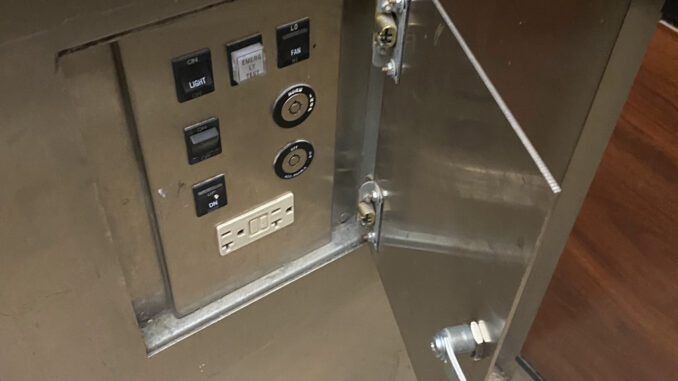
Zach Petroff | Opinions Editor
Feb. 09, 2023
It was close to midnight on Halloween night as Jane Glickman and Katherine Kane entered the elevator in Brottier on the main floor.
Eager to get to their room, Kane hit the button for the 15th floor but it did not illuminate, a suspicious omen for a building that doesn’t recognize the 13th floor.
The heavy doors closed shut and soon the seconds turned into minutes. Kane tried pressing the “Open Door” and the “L” button, but to no avail. It took about two minutes until they realized that they were trapped.
It was midnight on Halloween and two college women were stuck in an elevator.
“I tried to play it off as a joke, but yeah, I was a little scared,” Glickman said.
What these students experienced could be something straight out a horror film, but this is a reality for several students and faculty across campus, especially those in Brottier hall. Across campus, elevators are out of order or in need of repair.
According to Kenneth Walters, university media relations manager, there are 60 passenger elevators, seven freight or service elevators, seven wheelchair lifts and one dumbwaiter among all the campus-owned buildings..
Duquesne University currently has a service contract with Otis Elevator Company and a resident mechanic who reports to campus full time to do preventive maintenance and answer calls.
“Otis reported 62 repairs in the past six months,” Walters said. “That number is well within industry averages for repair calls. We attribute this to our robust service contract with Otis Elevator and the university’s capital investments in the elevator equipment.”
Students in Brottier Hall do not feel that the out-of-order elevators are “average.”
“I haven’t seen all three elevators working at all,” said Brottier Hall desk-aid, Torge Witteborg. “Before I came here, [residents] were already talking about it.”
Many students complain about the long wait times in the dormitories for a ride. Some have waited over 15 minutes before an elevator reaches their top floor.
Caitlin DeStefano is a student who lives on the 20th floor of Brottier hall. Classes at Duquesne follow a similar schedule between all majors, so when students leave their dorms, it’s not unusual to have a long line waiting to get to the main floor as others wait as well.
“I think the fact that they’re always broken is really annoying because, living on the top floor, I rely on coming from class at the same time as everyone else does,” DeStefano said. “On a good day there are two working.”
While long wait times are not unusual for elevators that have a lot of foot traffic, the breakdown of elevators is starting to become a common occurrence on campus.
Even when there are students inside.
“I was stuck on the ground level where the laundry is because the only way to get to the laundry room is you have to take the elevator,” said DeStefano. “I was stuck in the elevator with another girl for about five minutes until we called someone at the front desk.”
DeStefano’s experience lasted, by her account, around five minutes. However, some students have been forced to wait over an hour-and-a-half before being rescued.
On Oct. 31, roommates Glickman and Kane were waiting inside an elevator for over an hour for maintenance to come and open the elevator doors.
“We were deciding if we were truly stuck,” Glickman said, “then we decided we should probably call someone, so we just used the help button, and then I believe the front desk answered.”
Duquesne University police were on the scene five minutes later to make sure everyone was alright, but they were unable to do anything at the time.
After 45 minutes of waiting in the elevator, Glickman and Kane were still stuck.
“We were like ‘what is going on?’” Glickman said. “And then we were debating on actually calling the real police. So we pressed the help button again and [the front desk] said ‘maintenance is here, but they’re going to have to call the elevator company and get a service guy, and that is going to take an additional 30 minutes’.”
University police were eventually able to open the elevator with a crowbar.
The roommates would take another elevator to get to their floor.
“I didn’t want to get on the elevator again, but I didn’t want to [walk] up 15 flights,” Kane said.
Walking up the steps might occasionally work more reliably than the mechanic elevators.
“Elevators periodically need major repairs which can include replacing motors, cables, and controls. The university also invests in full upgrades – all new mechanical components and cab finishes – for elevators that become obsolete due to age,” Walter said in an email.
In addition to regular repair, Walter also shared future projects to assure optimal elevator operation on campus.
“Assumption Hall and two elevators in Libermann Hall are scheduled to be upgraded this summer,” he said.
As far as safety is concerned, Walter made it clear on what someone should do if they are in a situation where they are stuck in an elevator.
“The industry lingo for that situation is ‘entrapment,’” Walter said. He also shared what students should do if they find themselves stuck in a campus elevator.
“In that situation they should pick up the phone inside the elevator, which automatically rings through to public safety. Tell the dispatcher what building you are in and, if the elevator number is posted inside the car, what the elevator number is,” Walter said. “A public safety officer and facilities maintenance will be dispatched to the building to meet the Otis Elevator.”
Kane, who has already had to learn how to escape a stuck elevator, also had advice to give to those on campus.
“Don’t take the elevator, if you don’t have to. Live on the fourth floor or below.”
